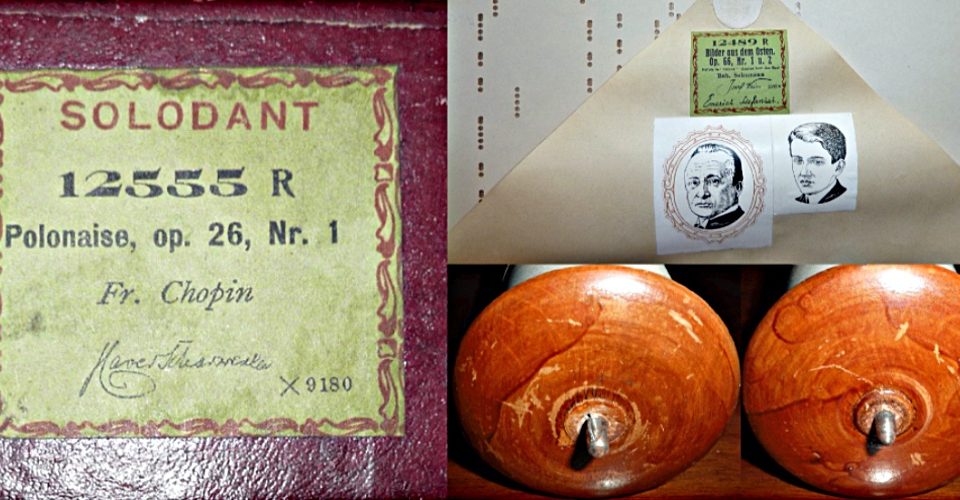
WIE SAHEN DIE KÜNSTLERVERTRÄGE BEI AMPICO AUS?
In 2020 digitalisierte die Stanford University / Stanford Libraries das tatsächlich noch erhaltene AMPICO ARTIST RECORD Buch (308 Seiten) aus den späten 1920er Jahren, das Alan H.

In 2020 digitalisierte die Stanford University / Stanford Libraries das tatsächlich noch erhaltene AMPICO ARTIST RECORD Buch (308 Seiten) aus den späten 1920er Jahren, das Alan H.

Die meisten Stücke, die auf Reproduktionsrollen aufgenommen worden, sind Piano Solo Stücke. Gleichwohl wurden auch Rollen hergestellt, die zur Liedbegleitung gedacht waren und so damals wie

Hugo Popper brachte 1908 das Reproduktionsklavier Stella auf den Markt und warb mit einem eigenen Aufnahmeapparat und einem eigenen exquisiten Repertoire. Tatsächlich scheint das Popper Stella

Die US Amerikanischen Welte-Licensee Rollen ähneln den Duo-Art und Ampico Notenrollen. Nach der Enteignung zum ersten Weltkrieg wurden die Amerikanischen Welte Geschäfte in den USA verkauft

Die Ampico Rollen basieren ebenfalls auf dem 88er Standardformat und haben zusätzlich die für die Reproduktion notwendigen Lochungen, so dass 83 Töne Gespielt werden. Die Ampico

Die Duo-Art Rollen der Aeolian Company basieren auf dem 88er Standardformat und haben zusätzlich die für die Reproduktion notwendigen Lochungen. Man kann die Duo-Art Notenrollen daher

1908 hat Philipps mit DUCA ein Konkurrenzsystem zur Hupfeld DEA und zum Welte-Mignon im Markt präsentiert. DUCA konnte einen Ton mehr anspielen als die beiden Konkurrenzsysteme

1919 hat Hupfeld die Weiterentwicklung des DEA Reproduktionssystem mit den Möglichkeiten der 88er Phonola verbunden und das Triphonola entwickelt, um 11 Jahre nach dessen Standardisierung auch

Als Hupfeld das DEA Reproduktionssystem ab 1907 anbot, konnte Hupfeld bereits auf die Phonoliszt bzw. Phonola Künstleraufnahmen zurückgreifen, die mindestens seit 1905 aufgezeichnet wurden. Wenngleich auch

Notenrollen für das ab 1924 hergestellte Welte-Mignon T98 System werden zumeist „Welte grün“ Rollen genannt, da das verwendete Papier meistens auffällig grün war. Auf den roten

1904 hat M. Welte & Söhne aus Freiburg die Welte-Mignon Notenrollen als erste Reproduktionsrollen auf den Markt gebracht. Die Welte-Mignon T100 Rollen werden zumeist „Welte rot“

Im 88er Standardformat wurden sehr viele Notenrollen unterschiedlicher Hersteller auf den Markt gebracht. Unter ihnen natürlich vor allem die Aeolian Company bzw. deren Deutsche Niederlassung Choralion

Die Hupfeld Notenrollen mit der 88er Skala wurden ab 1912 eingeführt und mit dem eingetragenen Warenzeichen „Animatic“ tituliert. ‚Anima‘ abgeleitet von ‚Seele‘. Diese Notenrollen sprechen alle

Hupfeld war in Deutschland der größte Anbieter für Künstlernotenrollen für die eigenen Hupfeld Phonola Kunstspielinstrumente. Die Phonola Notenrollen mit der 72/73er Skala wurden ab 1902 zunächst

Die Notenrollen mit einer Standard 65er Skala wurden von Aeolian bereits ab 1897 in Amerika mit der Pianola als Vorsetzer vermarktet und kamen damit noch vor

Die allermeisten Rollen lassen sich sehr leicht an bestimmten Merkmalen erkennen. Manche eher seltene Rollentypen geben zunächst Rätsel auf – und benötigen eine genauere Untersuchung. Die

Nach den Kriegen sind leider keine Aufnahmeflügel erhalten –und aus Geheimhaltungsgründen wurden auch keine Konstruktions- oder Patentunterlagen dazu veröffentlicht, so dass es bis heute nicht ganz

Sehr. Und das ist auch gut so. Selbst in dem Bemühen, so authentisch wie möglich die Idee und die Vorgaben des Komponisten umzusetzen, spielen Pianisten unterschiedlich.

Auch wenn die bis über 100Jahre alten Notenrollen oft noch gut erhalten sind, finden sich bei vielen Rollen allein durch die mehrfache Nutzung kleinere oder größere

Birgit Heise und ihr Team haben einen sehr interessanten Artikel in der DMM (Sep 2017) veröffentlicht – Thema: Die Künstlerverträge von Hupfeld. Diese Unterlagen sind Teil

Die verfügbaren Titel auf Notenrollen richteten sich nach dem jeweiligen Zeitgeschmack, der regional – also in Deutschland anders als in den USA- durchaus unterschiedlich war. Gleichzeitig

Wie auch bei Pianolas, unterscheiden sich die Notenrollen deutlich nach Hersteller, Alter und Typ. Es existieren zahlreiche unterschiedliche Rollentypen und diese passen jeweils nur für bestimmte